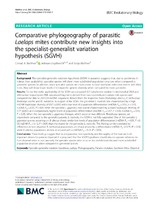| dc.contributor.author | Matthee, Conrad A. | |
| dc.contributor.author | Engelbrecht, Adriaan | |
| dc.contributor.author | Matthee, Sonja | |
| dc.date.accessioned | 2018-09-17T07:25:36Z | |
| dc.date.available | 2018-09-17T07:25:36Z | |
| dc.date.issued | 2018 | |
| dc.identifier.citation | Matthee, C.A. et al. Comparative phylogeography of parasitic Laelaps mites contribute new insights into the specialist-generalist variation hypothesis (SGVH). BMC Evolutionary Biology, 18: 131 | en_US |
| dc.identifier.issn | 1471-2148 | |
| dc.identifier.uri | https://doi.org/10.1186/s12862-018-1245-7 | |
| dc.identifier.uri | http://hdl.handle.net/10566/4045 | |
| dc.description.abstract | BACKGROUND: The specialist-generalist variation hypothesis (SGVH) in parasites suggests that, due to patchiness in
habitat (host availability), specialist species will show more subdivided population structure when compared to
generalist species. In addition, since specialist species are more prone to local stochastic extinction events with their
hosts, they will show lower levels of intraspecific genetic diversity when compared to more generalist.
RESULTS: To test the wider applicability of the SGVH we compared 337 cytochrome oxidase I mitochondrial DNA and
268 nuclear tropomyosin DNA sequenced fragments derived from two co-distributed Laelaps mite species and
compared the data to 294 COI mtDNA sequences derived from the respective hosts Rhabdomys dilectus, R. bechuanae,
Mastomys coucha and M. natalensis. In support of the SGVH, the generalist L. muricola was characterized by a high
mtDNA haplotypic diversity of 0.97 (±0.00) and a low level of population differentiation (mtDNA Fst= 0.56, p < 0.05;
nuDNA Fst = 0.33, P < 0.05) while the specialist L. giganteus was overall characterized by a lower haplotypic diversity of
0.77 (±0.03) and comparatively higher levels of population differentiation (mtDNA Fst = 0.87, P < 0.05; nuDNA Fst = 0.48,
P < 0.05). When the two specialist L. giganteus lineages, which occur on two different Rhabdomys species, are
respectively compared to the generalist parasite, L. muricola, the SGVH is not fully supported. One of the specialist L.
giganteus species occurring on R. dilectus shows similar low levels of population differentiation (mtDNA Fst= 0.53, P < 0.
05; nuDNA Fst= 0.12, P < 0.05) than that found for the generalist L. muricola. This finding can be correlated to
differences in host dispersal: R. bechuanae populations are characterized by a differentiated mtDNA Fst of 0.79 (P < 0.05)
while R. dilectus populations are less structured with a mtDNA Fst= 0.18 (P < 0.05).
CONCLUSION: These findings suggest that in ectoparasites, host specificity and the vagility of the host are both
important drivers for parasite dispersal. It is proposed that the SGHV hypothesis should also incorporate reference to
host dispersal since in our case only the specialist species who occur on less mobile hosts showed more subdivided
population structure when compared to generalist species. | en_US |
| dc.language.iso | en | en_US |
| dc.publisher | BMC | en_US |
| dc.rights | © The Author(s). 2018 Open Access This article is distributed under the terms of the Creative Commons Attribution 4.0
International License (http://creativecommons.org/licenses/by/4.0/), which permits unrestricted use, distribution, and
reproduction in any medium, provided you give appropriate credit to the original author(s) and the source, provide a link to
the Creative Commons license, and indicate if changes were made. The Creative Commons Public Domain Dedication waiver
(http://creativecommons.org/publicdomain/zero/1.0/) applies to the data made available in this article, unless otherwise stated. | |
| dc.subject | Specialist-generalist variation hypothesis | en_US |
| dc.subject | Laelaps | en_US |
| dc.subject | Phylogeography | en_US |
| dc.subject | Parasite evolution | en_US |
| dc.subject | Southern Africa | en_US |
| dc.subject | Dispersal | en_US |
| dc.title | Comparative phylogeography of parasitic Laelaps mites contribute new insights into the specialist-generalist variation hypothesis (SGVH) | en_US |
| dc.type | Article | en_US |
| dc.privacy.showsubmitter | FALSE | |
| dc.status.ispeerreviewed | TRUE | |

